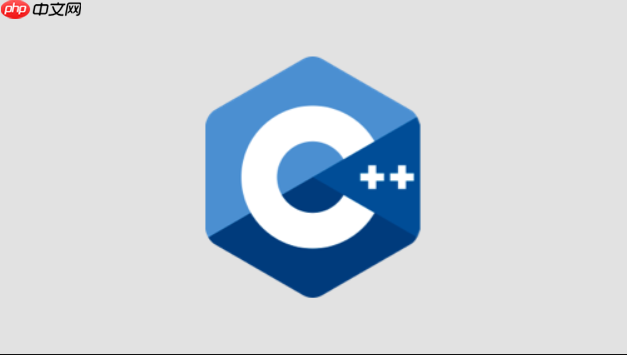装饰器模式通过组合而非继承,在不修改原有GUI组件代码的前提下动态扩展功能,有效避免类爆炸问题,提升灵活性与可维护性,符合开闭原则,但可能增加对象数量和调试复杂度。

C++中装饰器模式在GUI组件扩展的应用,核心在于它提供了一种无需修改现有类代码,就能动态地为对象添加新功能或职责的机制。这在GUI开发中尤其有用,因为我们经常需要在运行时为按钮、文本框等基础组件增加边框、滚动条、工具提示等多种特性,而传统的继承方式往往会导致复杂的类层次结构和“类爆炸”问题。装饰器模式通过将这些附加功能封装在独立的“装饰器”对象中,并允许它们以灵活的方式组合,优雅地解决了这一挑战,使得组件的扩展既灵活又符合开闭原则。
在GUI组件扩展中实践C++装饰器模式,我们首先需要定义一个所有GUI组件都遵循的统一接口,这通常是一个抽象基类或纯虚函数接口。例如,
IGUIComponent
draw()
handleEvent()
Button
TextBox
IGUIComponent
装饰器模式的关键在于引入一个抽象的
ComponentDecorator
IGUIComponent
IGUIComponent
ComponentDecorator
draw()
handleEvent()
具体的装饰器,比如
BorderDecorator
ScrollDecorator
ComponentDecorator
draw()
handleEvent()
BorderDecorator
draw()
立即学习“C++免费学习笔记(深入)”;
这种方式的妙处在于,当我们需要一个带边框、带滚动条的文本框时,无需创建一个
BorderedScrollableTextBox
TextBox
ScrollDecorator
BorderDecorator
new BorderDecorator(new ScrollDecorator(new TextBox()))
说实话,在GUI这种功能需求多变、组合复杂的场景里,传统的继承方式经常让人头疼。我记得有一次,我们团队想给一个基础的
Widget
BorderedWidget
Widget
ScrollableWidget
Widget
TooltipWidget
Widget
问题来了,如果我想要一个“带边框且可滚动”的
Widget
BorderedScrollableWidget
BorderedScrollableTooltipWidget
更糟糕的是,继承是静态的,功能在编译时就确定了。如果我想在运行时根据用户权限或者配置,动态地给某个组件加上或移除一个功能,继承就显得力不从心了。你不可能在运行时改变一个对象的继承链。而且,随着功能的增多,基类可能会变得臃肿,违反了单一职责原则。一个
Widget
实现装饰器模式,关键在于定义好接口和抽象层,然后具体化。在我看来,一个典型的C++实现会是这样:
首先,定义一个所有GUI组件都必须实现的抽象接口。

傻瓜式的程序安装和调试,用户无需考虑系统的安装维护,美观、友好的展示铺面,设计中应用了多种网络安全技术,顾客可以方便的查询并订购商品,用户可以方便的定义各种商品信息,系统选用强大的数据库保存各类信息,系统支持多种浏览器,功能模块清晰实用强大,系统有着良好的扩充性和升级性,强大的在线支付系统和订单系统登陆地址/admin/login.asp后台登陆账号:admin密码:admin
 0
0

// Component.h
#include <iostream>
#include <string>
class IGUIComponent {
public:
virtual ~IGUIComponent() = default;
virtual void draw() const = 0;
virtual void handleEvent(const std::string& event) = 0;
};接着,实现具体的GUI组件,比如一个简单的按钮。
// ConcreteComponent.h
#include "Component.h"
class Button : public IGUIComponent {
private:
std::string label;
public:
Button(const std::string& l) : label(l) {}
void draw() const override {
std::cout << "Drawing Button: " << label << std::endl;
}
void handleEvent(const std::string& event) override {
if (event == "click") {
std::cout << "Button '" << label << "' clicked!" << std::endl;
} else {
std::cout << "Button '" << label << "' received event: " << event << std::endl;
}
}
};然后,创建抽象的装饰器基类。它也实现了
IGUIComponent
IGUIComponent
// Decorator.h
#include "Component.h"
class ComponentDecorator : public IGUIComponent {
protected:
IGUIComponent* component; // 被装饰的组件
public:
ComponentDecorator(IGUIComponent* comp) : component(comp) {}
~ComponentDecorator() override {
// 负责删除内部组件,或者由客户端管理生命周期,这里简化为删除
delete component;
}
void draw() const override {
component->draw(); // 默认调用内部组件的绘制方法
}
void handleEvent(const std::string& event) override {
component->handleEvent(event); // 默认调用内部组件的事件处理方法
}
};最后,实现具体的装饰器类,它们继承自
ComponentDecorator
draw()
handleEvent()
// ConcreteDecorators.h
#include "Decorator.h"
class BorderDecorator : public ComponentDecorator {
public:
BorderDecorator(IGUIComponent* comp) : ComponentDecorator(comp) {}
void draw() const override {
std::cout << "Drawing Border around -> ";
component->draw(); // 调用内部组件的绘制
std::cout << "<- Border drawn." << std::endl;
}
// handleEvent 保持默认,或者添加边框相关的事件处理
};
class ScrollbarDecorator : public ComponentDecorator {
public:
ScrollbarDecorator(IGUIComponent* comp) : ComponentDecorator(comp) {}
void draw() const override {
component->draw(); // 调用内部组件的绘制
std::cout << "Adding Scrollbar to component." << std::endl;
}
void handleEvent(const std::string& event) override {
if (event == "scroll") {
std::cout << "Scrollbar handled scroll event." << std::endl;
} else {
component->handleEvent(event); // 其他事件传递给内部组件
}
}
};现在,我们就可以在
main
// main.cpp
#include "ConcreteComponent.h"
#include "ConcreteDecorators.h"
int main() {
// 一个普通的按钮
IGUIComponent* simpleButton = new Button("Submit");
std::cout << "--- Simple Button ---" << std::endl;
simpleButton->draw();
simpleButton->handleEvent("click");
std::cout << std::endl;
// 一个带边框的按钮
IGUIComponent* borderedButton = new BorderDecorator(new Button("Cancel"));
std::cout << "--- Bordered Button ---" << std::endl;
borderedButton->draw();
borderedButton->handleEvent("mouseover"); // 传递给内部组件
std::cout << std::endl;
// 一个带滚动条的按钮 (虽然按钮很少有滚动条,这里只是示例组合)
IGUIComponent* scrollableButton = new ScrollbarDecorator(new Button("Load More"));
std::cout << "--- Scrollable Button ---" << std::endl;
scrollableButton->draw();
scrollableButton->handleEvent("scroll");
std::cout << std::endl;
// 一个带边框且带滚动条的按钮
IGUIComponent* complexButton = new BorderDecorator(new ScrollbarDecorator(new Button("Confirm Order")));
std::cout << "--- Bordered & Scrollable Button ---" << std::endl;
complexButton->draw();
complexButton->handleEvent("click");
complexButton->handleEvent("scroll");
std::cout << std::endl;
// 清理内存
delete simpleButton; // 注意这里简单示例,实际需要根据生命周期管理策略来决定谁来delete
delete borderedButton;
delete scrollableButton;
delete complexButton;
return 0;
}这段代码展示了如何通过层层包装来动态组合功能。每个装饰器都只关注它自己的那部分功能,而不会去关心它所装饰的究竟是一个基础组件还是另一个已经被装饰过的组件。这正是装饰器模式的魅力所在。
在我多年的开发经验中,装饰器模式在GUI组件扩展方面确实展现出不少优势,但也并非没有它的“小脾气”。
实际优势:
潜在挑战:
IGUIComponent
delete
总的来说,装饰器模式在GUI组件扩展方面是把“利器”,它赋予了我们极大的灵活性和可维护性。但使用时也需留意其可能带来的额外复杂性,并在设计阶段就考虑好对象的生命周期管理和接口的稳定性。
以上就是C++装饰器模式在GUI组件扩展中的应用的详细内容,更多请关注php中文网其它相关文章!

每个人都需要一台速度更快、更稳定的 PC。随着时间的推移,垃圾文件、旧注册表数据和不必要的后台进程会占用资源并降低性能。幸运的是,许多工具可以让 Windows 保持平稳运行。

Copyright 2014-2025 https://www.php.cn/ All Rights Reserved | php.cn | 湘ICP备2023035733号